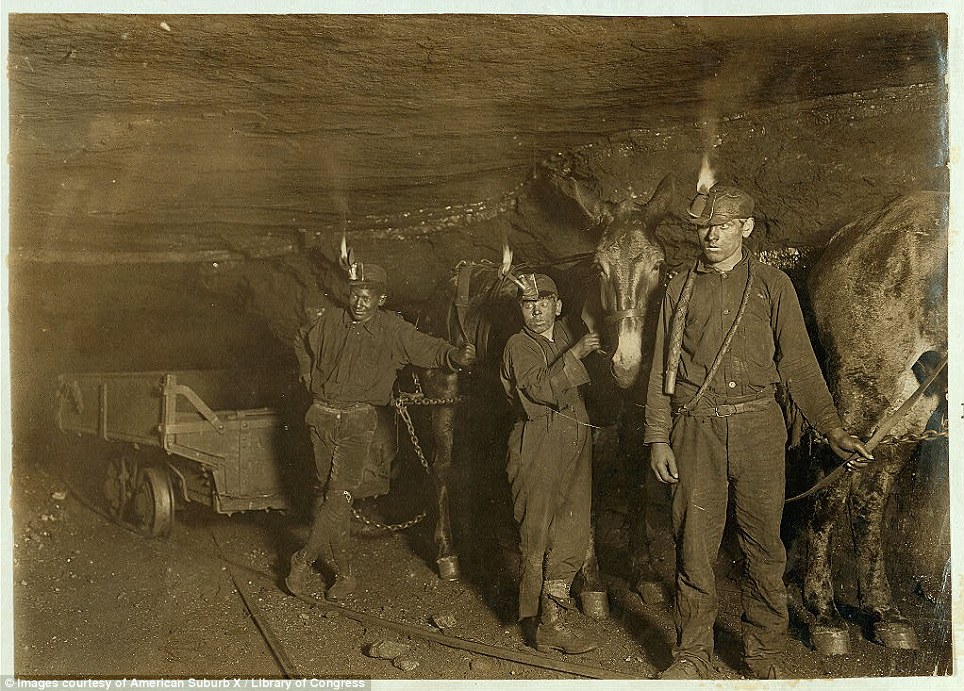Working as an investigative photographer for the National Child Labor Committee, sociologist Lewis Hine documented the working and living conditions of children in the United States between 1908 and 1924.
He travelled around 50,000 miles a year, photographing children from Chicago to Florida working in coal mines, factories and cotton mills for the lobbying organisation.
His hard-hitting body of work, profiled by America Suburb X consists of more than 5,000 images, ultimately helped bring about stricter labour laws and gave youngsters their childhoods back.
His poignant pictures show young children with their faces covered in dirt who have spent most of their lives working in horrendous conditions.
Many sustained broken bones and suffered from stunted growth and curvature of the spine because of the unsafe conditions and worked long hours on poor pay.
The photographer would sneak into factories, often hiding his camera and posing as a fire inspector. He risked being beaten by managers if they discovered him.
Hine secretly interviewed his subjects, noting down their ages and duties in a notepad he kept hidden in his jacket.
He captioned his photos accordingly and made no attempt to exaggerate their poverty, arguing that people were more likely to support a campaign against child labour if they felt the pictures accurately depicted the conditions.
The demand for child labour was a result of the boom in industry at the end of the 19th century. Businesses sought immigrant and child workers to complete cheap labour. Many saw children, with their small hands and energy, as ideal employees.
But at the turn of the century, some reformists started voicing their concerns over the children's welfare and the negative effects on their education. There were fears the practice would stunt America in years to come because of a high number of overworked, under-educated youths.
Set up on 1904, the National Child Labour Committee worked state by state to lobby legislatures to adopt regulations. In 1915, its efforts started to focus on the federal level.
In 1916, Congress agreed to pass legislation to protect children and restrictions were placed on the employment of children aged under 14 in factories and shops.
And in 1938, after a series of failed or retracted laws, the Committee supported the Fair Labor Standards Act, which prohibited any interstate commerce of goods made through oppressive child labor.
'Oppressive child labor' was defined as any form of employment for children under sixteen and any particularly hazardous occupation for children ages sixteen to eighteen, excluding agricultural labour.
President Franklin D. Roosevelt signed the bill into law on June 25, 1938; it still stands today and acts as the basic protection for children across the U.S.
LEWIS HINE: “WANTED SMALL BOYS – APPLY 1ST FLOOR” « ASX | AMERICAN SUBURB X | Photography & Culture

He travelled around 50,000 miles a year, photographing children from Chicago to Florida working in coal mines, factories and cotton mills for the lobbying organisation.
His hard-hitting body of work, profiled by America Suburb X consists of more than 5,000 images, ultimately helped bring about stricter labour laws and gave youngsters their childhoods back.
His poignant pictures show young children with their faces covered in dirt who have spent most of their lives working in horrendous conditions.
Many sustained broken bones and suffered from stunted growth and curvature of the spine because of the unsafe conditions and worked long hours on poor pay.
The photographer would sneak into factories, often hiding his camera and posing as a fire inspector. He risked being beaten by managers if they discovered him.
Hine secretly interviewed his subjects, noting down their ages and duties in a notepad he kept hidden in his jacket.
He captioned his photos accordingly and made no attempt to exaggerate their poverty, arguing that people were more likely to support a campaign against child labour if they felt the pictures accurately depicted the conditions.
The demand for child labour was a result of the boom in industry at the end of the 19th century. Businesses sought immigrant and child workers to complete cheap labour. Many saw children, with their small hands and energy, as ideal employees.
But at the turn of the century, some reformists started voicing their concerns over the children's welfare and the negative effects on their education. There were fears the practice would stunt America in years to come because of a high number of overworked, under-educated youths.
Set up on 1904, the National Child Labour Committee worked state by state to lobby legislatures to adopt regulations. In 1915, its efforts started to focus on the federal level.
In 1916, Congress agreed to pass legislation to protect children and restrictions were placed on the employment of children aged under 14 in factories and shops.
And in 1938, after a series of failed or retracted laws, the Committee supported the Fair Labor Standards Act, which prohibited any interstate commerce of goods made through oppressive child labor.
'Oppressive child labor' was defined as any form of employment for children under sixteen and any particularly hazardous occupation for children ages sixteen to eighteen, excluding agricultural labour.
President Franklin D. Roosevelt signed the bill into law on June 25, 1938; it still stands today and acts as the basic protection for children across the U.S.
LEWIS HINE: “WANTED SMALL BOYS – APPLY 1ST FLOOR” « ASX | AMERICAN SUBURB X | Photography & Culture
